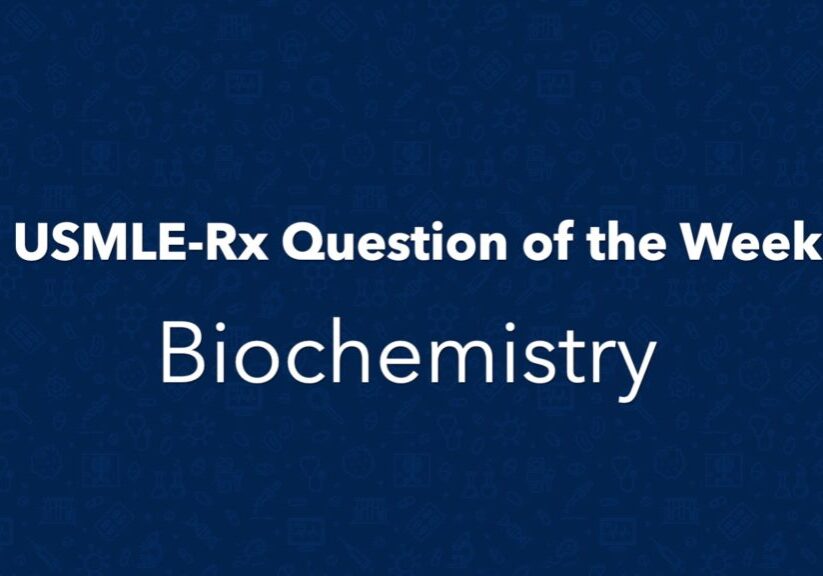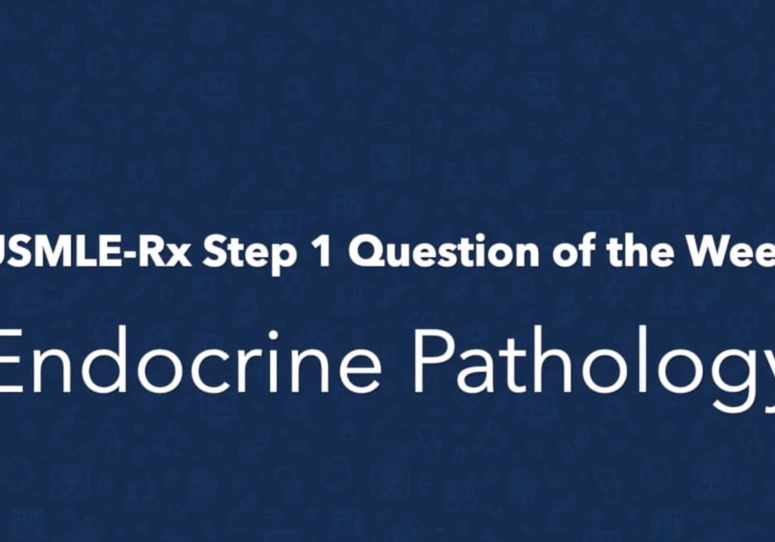Check out today’s Step 1 Qmax Question Challenge.
Know the answer? Post it below! Don’t forget to check back for an update with the correct answer and explanation (we’ll post it in the comments section below).
 A 19-year-old college student presents for evaluation of persistently enlarged nontender supraclavicular lymph nodes. She says she is otherwise healthy and provides no significant medical history. She is experiencing night sweats and has had a 4.5-kg (10-lb) weight loss over the past 3 months. Three supraclavicular lymph nodes are palpable above her right shoulder. No other lymphadenopathy is noted. On X-ray of the chest, mediastinal lymphadenopathy is noted. Results of a lymph node biopsy are shown in the image.
A 19-year-old college student presents for evaluation of persistently enlarged nontender supraclavicular lymph nodes. She says she is otherwise healthy and provides no significant medical history. She is experiencing night sweats and has had a 4.5-kg (10-lb) weight loss over the past 3 months. Three supraclavicular lymph nodes are palpable above her right shoulder. No other lymphadenopathy is noted. On X-ray of the chest, mediastinal lymphadenopathy is noted. Results of a lymph node biopsy are shown in the image.
Which of the following is the most likely diagnosis?
A. Burkitt lymphoma
B. Follicular lymphoma
C. Hodgkin lymphoma, lymphocyte-depleted type
D. Hodgkin lymphoma, nodular-sclerosing type
E. T-lymphocyte lymphoblastic lymphoma
———————–
Want to know the ‘bottom line?’ Purchase a USMLE-Rx Subscription and get many more features, more questions, and passages from First Aid, including images, references, and other facts relevant to this question.
This practice question is an actual question from the USMLE-Rx Step 1 test bank. For more USMLE Step 1 prep, subscribe to our Flash Facts and Step 1 Express video series. Score the best deal on all three products with a Step 1 Triple Play Bundle.




D
HODGKIN, SCLEROSING TYPE
c
oops…D
The correct answer is D. This patient has the classic presentation of Hodgkin lymphoma, with night sweats, weight loss, and peripheral lymphadenopathy localized to a single group of nodes. Mediastinal lymphadenopathy is a classic finding of Hodgkin lymphoma, particularly the nodular-sclerosing subtype (see image on the left). Nodular-sclerosing Hodgkin usually presents in young women. It is characterized by lacunar cells, a variant of malignant Reed-Sternberg (RS) cells; cytoplasmic retraction occurs during tissue fixation, causing them to appear separated from other cells by a clear space (lacunae–see image on the right). Therefore, lacunar cells and the deposition of collagen are characteristic histologic findings of the nodular-sclerosing type. This class of Hodgkin lymphoma tends to behave less aggressively, and generally has an excellent prognosis. Usually, few RS cells are seen in patients with this form of the disease.
A is not correct. Burkitt lymphoma is seen more commonly in children; the endemic form seen in Africa is associated with jaw involvement. The sporadic form would occur typically in the abdomen or pelvis. Burkitt lymphoma is associated with the t(8;14) c-myc chromosomal translocation, Epstein-Barr virus infection, and the histologic appearance of a starry sky (shown in this image).
B is not correct. Follicular lymphoma involves a t(14;18) translocation, which activates the anti-apoptotic bcl-2 protooncogene. Lymph node biopsy would demonstrate lymph node effacement (as shown here). Non-Hodgkin lymphoma is associated with immunosuppression, with multiple peripheral nodal involvement as well as extra-nodal involvement, and has few constitutional symptoms.
C is not correct. This is a rare form of Hodgkin lymphoma. In addition, it is seen most commonly in older male patients or HIV-positive patients who present with disseminated disease. In general, when analyzing Hodgkin lymphoma specimens, a greater number of RS cells in a biopsy specimen means a worse prognosis. Nodular-sclerosing Hodgkin lymphoma has very few RS cells and usually can be cured, whereas lymphocyte-depleted Hodgkin lymphoma, the subtype with the worst prognosis, produces specimens that are dominated by RS cells.
E is not correct. T-lymphocyte lymphoblastic lymphoma is a neoplasm that occurs most often in children. Although it can be associated with a mediastinal mass, the patient’s classic presentation for Hodgkin disease makes this non-Hodgkin lymphoma unlikely.
Very good explanation, especially Ddx between HD Nodular Sclerosing and Follicular lymphoma. Thanks
how much cbd oil would it take to show up on a drug test